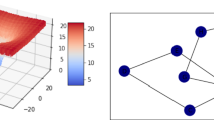Abstract
Different parallelization methods vary in their system requirements, programming styles, efficiency of exploring parallelism, and the application characteristics they can handle. For different situations, they can exhibit totally different performance gains. This paper compares OpenMP, MPI, and Strings for parallelizing a complicated tribology problem. The problem size and computing infrastructure is changed to assess the impact of this on various parallelization methods. All of them exhibit good performance improvements and it exhibits the necessity and importance of applying parallelization in this field.
Similar content being viewed by others
References
S. Roy, R. Y. Jin, V. Chaudhary, and W. L. Hase. Parallel molecular dynamics simulations of alkane/hydroxylated α-aluminum oxide interfaces. Computer Physics Communications, 128:210–218, 2000.
D. Cociorva, G. Baumgartner, C. Lam, P. Sadayappan, J. Ramanujam, M. Nooijen, D. Bernholdt, and R. Harrison. Space-time trade-off optimization for a class of electronic structure calculations. Proceedings of ACM SIGPLAN 2002 Conference on Programming Language Design and Implementation (PLDI), June 2002.
G. Baumgartner, D. Bernholdt, D. Cociorva, R. Harrison, M. Nooijen, J. Ramanujam, and P. Sadayappan. A performance optimization framework for compilation of tensor contraction expressions into parallel programs. 7th International Workshop on High-Level Parallel Programming Models and Supportive Environments (held in conjunction with IPDPS' 02), April 2002.
V. Grover and D. Walls. Sun MP C Compiler, http://docs.sun.com/
Sun Microsystems, Sun Performance Library User's Guide, http://docs.sun.com/
The OpenMP Forum, OpenMP: Simple, Portable, Scalable SMP Programming, http://www. openmp.org/
National Energy Research Scientific Computing Cetner, NERSC OpenMP Tutorial, http://hpcf.nersc.gov/training/tutorials/openmp/
Message passing interface (MPI) forum, MPI: A message-passing interface standard. International Journal of Supercomputing Applications, 8(3/4), 1994.
W. Gropp, E. Lusk, N. Doss, and A. Skjellum. High-performance, portable implementation of the MPI message passing interface standard. Parallel Computing, 22(6), 1996.
A. Itzkovitz, A. Schuster, and L. Wolfovich. Thread migration and its applications in distributed shared memory systems. Journal of Systems and Software, 42(1):71–87, 1998.
P. Keleher, A. Cox, S. Dwarkadas, and W. Zwaenepoel. TreadMarks: Distributed shared memory on standard workstations and operating systems. Proceeding of the Winter 1994 USENIX Conference, 1994.
S. Roy and V. Chaudhary. Design issues for a high-performance DSM on SMP clusters. Journal of Cluster Computing, 2(3):177–186, 1999.
M. O. Robbins and M. H. Mser. Computer simulation of friction, lubrication, and wear. In B. Bhushan, ed., Modern Tribology Handbook, p. 717. CRC press, Boca Raton, 2001.
I. L. Singer. Friction and energy dissipation at the atomic scale: A review. Journal of Vacuum Science and Technology, A, 12:5, 1994.
R. W. Carpick and M. Salmeron. Scratching the surface: Fundamental investigations of tribology with atomic force microscopy. Chemical Review, 97:1163–1194, 1997.
Parallel Computing in Computational Chemistry: Developed from a symposium sponsored by the Division of Computers in Chemistry at the 207th National Meeting of the American Chemical Society, San Diego, California, Timothy G. Mattson, ed., Washington, DC, American Chemical Society. March 13-17, 1994.
J. M. Wittbrodt, W. L. Hase, and H. B. Schlegel. Ab Initio study of the interaction of water with cluster models of the aluminum terminated (0001) α-aluminum oxide surface. Journal of Physical Chemistry B, 102:6539–6548, 1998.
H. J. C. Berendsen, J. P. M. Postma, W. F. van Gunsteren, A. Di-Nola, and J. R. Haak. Moleculardynamics with coupling to an external bath. Journal of Chemical Physics, 81:3684–3690, 1984.
W. C. Swope, H. C. Andersen, P. H. Berens, and K. R. Wilson. A computer-simulation method for the calculation of equilibrium-constants for the formation of physical clusters of molecules-application to small water clusters. Journal of Chemical Physics, 76:637–649, 1982.
S. Y. Liem, D. Brown, and J. H. R. Clarke. A loose-coupling, constant pressure, molecular dynamics algorithm for use in the modeling of polymer materials. Computer Physics Communication, 62:360–369, 1991.
D. Brown, J. H. R. Clarke, M. Okuda, and T. Yamazaki. A domain decomposition parallel-processing algorithm for molecular dynamics simulations of polymers. Computer Physics Communication, 83:1–13, 1994.
D. Brown, J. H. R. Clarke, M. Okuda, and T. Yamazaki. A domain decomposition parallelization strategy for molecular dynamics simulations on distributed memory machines. Computer Physics Communication, 74:67–80, 1993.
S. Plimpton. Fast parallel algorithms for short range molecular dynamics. Journal of Computational Physics, 117:1–19, 1995.
R. Murty and D. Okunbor. Efficient parallel algorithms for molecular dynamics simulation. Parallel Computing, 25:217–230, 1999.
Rights and permissions
About this article
Cite this article
Chaudhary, V., Hase, W.L., Jiang, H. et al. Experiments with Parallelizing Tribology Simulations. The Journal of Supercomputing 28, 323–343 (2004). https://doi.org/10.1023/B:SUPE.0000022103.01620.f3
Issue Date:
DOI: https://doi.org/10.1023/B:SUPE.0000022103.01620.f3




